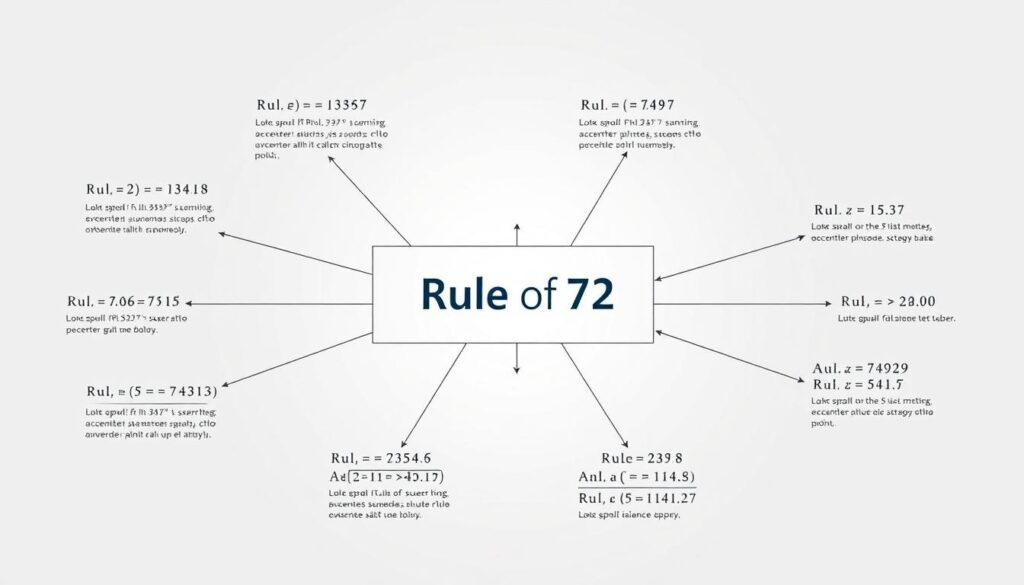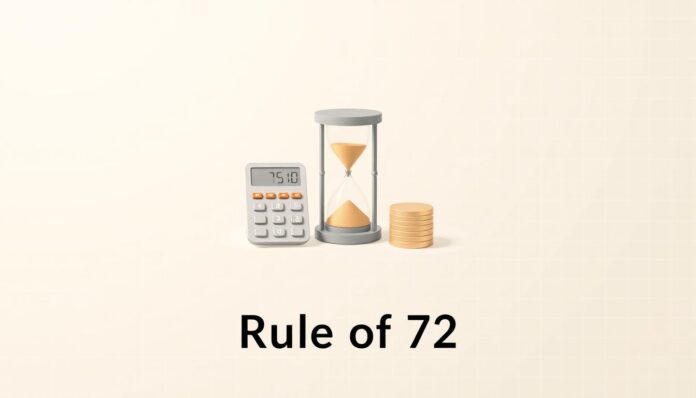The Rule of 72 in Finance is a simple tool to estimate how long it takes for investments to double. This Rule of 72 definition uses basic math: divide 72 by an annual interest rate to find the years needed. It’s the Rule of 72 explained as a quick mental shortcut for growth projections.
Whether saving for retirement or growing a portfolio, the Rule of 72 explained helps visualize compound interest’s power. Investors use it to compare options, set realistic goals, and avoid overcomplicating decisions. The Rule of 72 in Finance works best for interest rates between 6% and 10%, making it practical for everyday planning.
Key Takeaways
- Estimates doubling time by dividing 72 by an investment’s annual rate.
- Simplifies complex calculations for quick financial decisions.
- Applies to compound interest scenarios like savings accounts or stocks.
- Helps compare investment options without detailed formulas.
- Most accurate for interest rates between 6% and 10%.
What is the Rule of 72 in Finance?
The Rule of 72 is a foundational tool for anyone navigating the world of investments. At its core, the Rule of 72 definition is straightforward: it’s a quick way to estimate how long it takes for money to double at a specific interest rate. Let’s break it down further.
The Basic Concept of the Rule of 72
The Rule of 72 formula works by dividing 72 by the annual interest rate. For instance, at 6% growth, 72 ÷ 6 = 12 years to double. Here’s a quick comparison:
| Interest Rate | Years to Double |
|---|---|
| 6% | 12 years |
| 9% | 8 years |
| 12% | 6 years |

Importance in Financial Planning
The Rule of 72 significance lies in its simplicity. It helps investors compare opportunities without complex math. For example, choosing between a 4% savings account or a 7% stock investment? The rule shows the stock doubles in 10.3 years vs. 18 years for savings. This clarity sharpens decision-making. As highlighted in financial intelligence resources, such tools turn abstract numbers into actionable insights.
How to Use the Rule of 72 for Investments
Turning theory into action is key to mastering the Rule of 72. Here’s how to apply it practically to real money decisions.
Calculating Investment Growth
Master the Rule of 72 calculation in three steps:
- Divide 72 by your investment’s annual interest rate. Example: At 6% interest, 72 ÷ 6 = 12 years to double.
- Adjust for varying rates. Lower rates take longer; higher rates speed up doubling time.
- Apply the result to your savings. A $10,000 investment at 8% doubles to $20,000 in 9 years (72 ÷ 8 = 9).
Examples of Real-Life Application
“The Rule of 72 strips complexity from compound interest, making smart choices simple.”
- Retirement Planning: At 7% annual returns, savings double every ~10.3 years (72 ÷ 7 ≈ 10.28).)
- College Savings: A 5% growth rate means a $20,000 education fund doubles to $40,000 in 14.4 years.
- Comparing Investments: A CD at 3% takes 24 years to double vs. stocks at 9% needing 8 years. The Rule of 72 application highlights why higher returns matter.
Use this tool to compare options, set realistic timelines, and pick strategies matching your goals. Simple math, big insights!
When is the Rule of 72 Most Effective?

TheRule of 72 explainedis a quick tool, but its effectiveness depends on how you use it. Let’s look at when it works best and where it might fall short.
Appropriate Contexts for Use
TheRule of 72 applicationshines in situations with:
- Steady interest rates, like fixed savings accounts or long-term bonds.
- Compound interest investments where growth compounds regularly (e.g., retirement accounts).
- Quick comparisons between investment options without complex math.
For instance, estimating how long it takes for a 8% annual return to double? Divide 72 by 8—9 years. Simple and practical!
Limitations and Considerations
While handy, the rule has limits. It’s less precise at extreme interest rates. For rates below 6% or above 10%, use aRule of 72 calculatorfor accuracy. Taxes, fees, or variable rates also reduce its reliability.
Remember, the rule is a starting point. Pair it with detailed calculators for critical decisions. It’s like a map—it guides you but doesn’t show every pothole!
Comparing the Rule of 72 with Other Financial Tools
The Rule of 72 isn’t the only tool for estimating investment growth, but it stands out for its simplicity. Let’s explore how it stacks up against alternatives and why it remains a favorite among financial planners.
Other Methods of Estimation
Several tools exist to calculate growth timelines, each suited to different scenarios. For example:
- Rule of 69: Preferred for continuous compounding, used in advanced finance.
- Rule of 70: Common in population growth studies, slightly less precise for annual interest.
- NPV/IRR formulas: Complex but exact, requiring calculators or spreadsheets.
| Method | Best Use Case | Accuracy |
|---|---|---|
| Rule of 72 | Quick mental Rule of 72 calculation for annual compounding | High for typical interest rates |
| Rule of 69 | Continuous compounding scenarios | More precise for exponential growth |
Advantages of the Rule of 72
ItsRule of 72 significancelies in three key strengths:
- Speed: No calculator needed—just divide 72 by the interest rate.
- Memorability: The number 72 is easy to recall compared to complex equations.
- Accessibility: Works well for most everyday financial planning needs.
While advanced tools exist, the Rule of 72 remains a go-to shortcut for quick decisions. Its blend of accuracy and simplicity makes it a timeless tool in theRule of 72 in Financetoolkit.
How the Rule of 72 Can Impact Your Financial Decisions
Mastering the Rule of 72 in Finance transforms how you approach money. This simple tool, based on its formula (72 divided by annual interest rate), reveals how quickly investments can double. Applying it strategically sharpens long-term goals and everyday choices.
Long-Term Planning Benefits
A Rule of 72 example shows its power in retirement planning. Suppose you invest $50,000 at 6%. Using the formula, it doubles in 12 years (72 ÷ 6 = 12). By age 40, that $50k becomes $100k by 52. Small rate changes matter: 8% shortens doubling time to 9 years, adding decades of growth. This clarity helps prioritize high-return options for education funds, real estate, or savings accounts.
Incorporating the Rule into Your Strategy
Start by comparing investment options. For instance, a 4% savings account vs. a 7% stock fund. The Rule of 72 formula shows the stock fund doubles in ~10 years, versus 18 years for the account. Use it to set milestones: if college costs double in 12 years, start saving early. Share the rule with family to explain compound growth. Pair it with tools like retirement calculators but keep the Rule of 72 as a quick sanity check for goals.

A writer, editor, and publisher with a knack for crafting informative articles.

